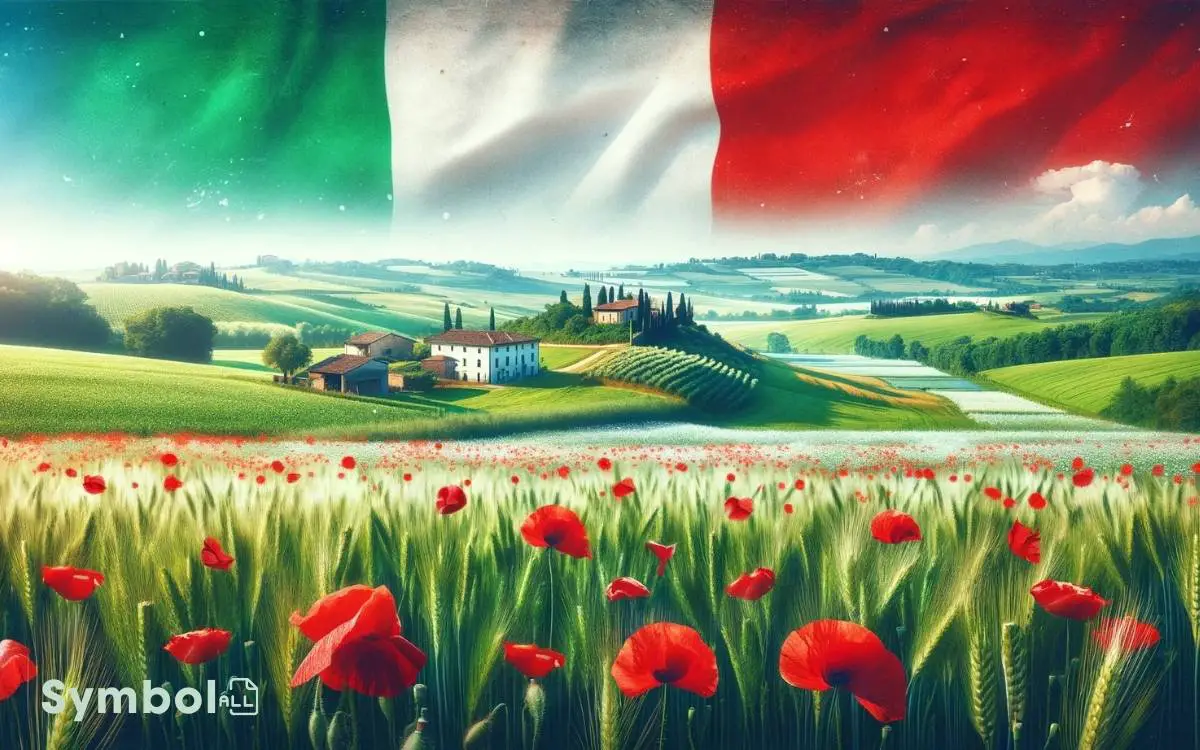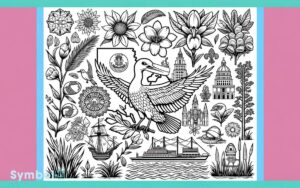What Do the Colors of the Italian Flag Symbolize? Explained!
You’re likely familiar with the Italian flag, but have you ever wondered what its colors truly stand for? The green on the flag celebrates Italy’s lush landscapes, reflecting the nation’s rich agricultural heritage and geographical diversity.
The white symbolizes peace and unity, key elements that were pivotal during Italy’s unification in the 19th century.
Lastly, the red honors the sacrifices and courage of those who fought for Italy’s freedom, representing the blood shed by martyrs throughout Italy’s history.
Together, these colors encapsulate Italy’s struggles and hopes, embodying a sense of national pride and identity. There’s more to these colors than meets the eye, hinting at deeper stories and symbolism.

Key Takeaway
The Italian Flag: An Overview
When delving into the Italian flag, it’s important to grasp that its three vertical stripes of green, white, and red hold profound historical importance and national identity.
You’ll find that each color isn’t just a random selection; they’re imbued with meaning and reflect the country’s essence at different levels. The flag, known in Italian as ‘il Tricolore,’ symbolizes unity, freedom, and the shared values of the Italian Republic. The green, white, and red of the Italian flag echo themes of hope, faith, and charity, adding depth to its historical significance. Similarly, much like the mexican flag colors symbolism, these hues often serve as a bridge between a nation’s past and its collective identity. Through their vibrant display, flags like Italy’s and Mexico’s narrate stories of resilience, independence, and the enduring pride of their people.
It’s a visual representation of Italy’s journey through history, its struggles, and triumphs. As you explore the flag’s significance, you’ll uncover how deeply it’s woven into the fabric of Italian society, standing as a tribute to the nation’s enduring spirit and cultural pride.
This understanding enriches your grasp of Italy’s identity, beyond the surface-level interpretation of colors.
Historical Origins of the Colors
Exploring the historical origins of the Italian flag’s colors reveals how deeply they’re rooted in the nation’s past, embodying the struggles and aspirations of its people.
The tricolor of green, white, and red first emerged in the late 18th century, inspired by the French Revolution, symbolizing a new era of liberty and unity.
Initially, these colors were adopted by the Cispadane Republic in 1797, reflecting a collective identity among Italian states aiming for independence and unification.
The flag’s design, though influenced by external revolutions, quickly became a unique symbol of Italian nationalism.
Its hues weren’t randomly chosen but were imbued with the spirit of the Risorgimento, the movement leading to the consolidation of Italy.
This convergence of historical events and ideological fervor gave birth to a national emblem that transcends mere colors.
Green: Italys Landscapes
As you delve into the significance of green in the Italian flag, you’re fundamentally unraveling the story of Italy’s breathtaking landscapes.
This hue mirrors the country’s verdant countryside beauty and its fertile agricultural regions, aspects that are crucial to Italy’s identity and economy.
They not only contribute to the aesthetic appeal but also signify the rich agricultural heritage that sustains the nation.
Lush Countryside Beauty
Gazing upon Italy’s landscapes, you’re immediately struck by the vibrant green hues that encapsulate the nation’s lush countryside beauty.
This verdant color, a prominent feature of the Italian flag, is deeply symbolic, representing more than just the surface level of scenic views.
It explores the essence of Italy’s geographical diversity, from the rolling hills of Tuscany to the expansive, olive tree-dotted plains of Umbria and the rich, dense forests of the Alps and Apennines.
Each shade of green paints a picture of Italy’s varied natural topography, offering a visual proof to the country’s ecological richness.
It’s a celebration of nature’s bounty, capturing the essence of Italy’s landscapes without investigating into the specifics of agricultural productivity, focusing instead on the panoramic beauty that defines the country.
Fertile Agricultural Regions
Beyond the picturesque landscapes, Italy’s verdant expanses are also a demonstration of its fertile agricultural regions, pivotal in shaping the nation’s culinary and cultural heritage.
These regions aren’t just swathes of greenery; they’re the backbone of Italy’s renowned food and wine industries.
The green in the flag encapsulates this richness, symbolizing the country’s vast vineyards, olive groves, and fertile plains that yield an abundance of fruits, vegetables, and grains.
Each region, from Tuscany’s rolling hills to Sicily’s citrus orchards, contributes uniquely to the tapestry of Italian cuisine, underscoring the importance of agriculture in Italian life.
Therefore, the green color serves as a constant reminder of Italy’s deep connection to its land, a source of pride, sustenance, and identity for its people.
White: Peace and Unity
The white band on the Italian flag symbolizes the nation’s longstanding commitment to peace and unity, reflecting its core values and aspirations.
This emblematic color serves as a reminder of Italy’s pursuit of harmonious coexistence, both within its borders and in its international relations.
Historically, the inclusion of white in the flag has been interpreted as a desire to bridge differences and foster a sense of togetherness among the Italian states, especially during the unification process in the 19th century.
It’s a proof of the country’s dedication to creating a cohesive society where dialogue and cooperation prevail over division.
Red: The Blood of Martyrs
While white reflects Italy’s aspirations for peace and unity, red honors the sacrifice and courage of those who fought for the country’s freedom and unity, symbolizing the blood shed by martyrs throughout its history.
This vibrant color serves as a poignant reminder of the struggles endured by Italian patriots and revolutionaries, underscoring the profound cost of Italy’s unification and independence.
The red in the flag isn’t just a color; it’s a tribute to the countless lives lost in the pursuit of a nation’s sovereignty. It embodies the deep-seated resilience and fervor that propelled Italy through tumultuous periods.
By incorporating red, the flag encapsulates not only the nation’s triumphant victories but also its solemn history of sacrifice, urging you to remember and respect the price of freedom.
Influence of the French Tricolor
You must consider the seismic impact of the French Revolution, which reshaped European ideologies and directly influenced the symbolism change in the Italian flag.
The origins of Italy’s tricolor flag are deeply intertwined with the principles of liberty, equality, and fraternity that the French Tricolor embodies.
This adoption reflects not just a political alignment, but a profound cultural and ideological shift that occurred in Italy during this period.
French Revolution Impact
France’s revolutionary fervor greatly influenced the Italian flag’s design, symbolized by the tricolor, reflecting a shared aspiration for liberty and unity. This impact goes beyond mere visual similarity; it represents a profound ideological influence.
The French Revolution, with its ideals of liberty, equality, and fraternity, resonated deeply in the Italian states, which were seeking to break free from foreign domination and internal fragmentation.
The adoption of a tricolor flag in Italy wasn’t just an aesthetic choice; it was a deliberate nod to the transformative power of the French Revolution.
It symbolized a desire to emulate France’s path to unity and independence, embedding these aspirations in the very fabric of the nation.
Accordingly, the French tricolor’s influence extends beyond colors to embody the spirit of revolution and unity.
Symbolism Transition Origins
Understanding the origins of the symbolism in the Italian flag requires examining the profound influence of the French tricolor, which served as both inspiration and ideological beacon for Italy’s unification efforts.
The French flag’s colors weren’t just aesthetic choices but carried deep-seated meanings that resonated with the Italian revolutionaries and patriots.
- Liberty: The French tricolor symbolized the revolutionary ideals of liberty, which the Italians sought to embody in their own flag.
- Equality: Equality before the law, another cornerstone of the French Revolution, found its reflection in the Italian tricolor.
- Fraternity: The sense of brotherhood among nations and within the emerging Italian state.
- Unity: A united Italy looked to the unified French Republic as a model.
- Independence: Aiming for independence from foreign rule and local despots, inspired by France’s successful revolution.
The Cispadane Republic Connection
The Cispadane Republic, established in 1796, played a pivotal role in the adoption of the Italian flag’s colors, symbolizing a new era of unity and independence within Italy.
| Year | Event | Significance |
|---|---|---|
| 1796 | Establishment of the Cispadane Republic | Marked the first use of green, white, and red as a symbol of Italian unity |
| 1797 | Adoption of the Tricolor | Official recognition of the colors representing the Republic |
| 1797 | First Public Display | The flag was publicly displayed, rallying support for independence |
| 1797 | Symbolic Representation | Green for the plains and hills, white for the snow-capped Alps, red for the blood spilled for independence |
| 1798 | Dissolution of the Republic | Despite its short existence, the flag’s symbolism endured, influencing future Italian unification efforts |
This movement wasn’t just political; it embedded a deep-seated symbol of hope and collective identity among Italians, setting the stage for future unification endeavors.
Unification and National Pride
You’ll find that the Italian flag’s colors carry deep narratives of historical unification and national pride.
These hues not only symbolize the country’s journey toward unity but also stand as enduring symbols of national identity.
Historical Unification Impact
Italy’s unification in the 19th century profoundly strengthened national pride, with the flag’s colors symbolizing the newfound unity and identity of the Italian people.
This unification wasn’t just a political milestone; it was a cultural renaissance that deeply impacted Italy’s societal fabric.
Let’s explore how this pivotal event transformed the nation:
- Unified legal and political systems streamlined governance.
- Enhanced communication networks fostered a sense of national community.
- Economic policies were harmonized, spurring growth and stability.
- Educational reforms promoted a unified national consciousness.
- The arts flourished, reflecting and nurturing Italian identity.
Analyzing these points, you’ll see that the unification didn’t merely merge territories; it built the framework for a modern, unified Italy, with the flag standing as a proud emblem of this transformation.
Symbols of National Identity
Exploring the symbols of national identity reveals how unification and national pride are intricately intertwined, manifesting in elements like the Italian flag, which serves as a potent emblem of unity and shared heritage.
You’ll find that each color on the flag green, white, and red doesn’t just stand for abstract ideals but embodies the very essence of Italy’s struggle for independence and its rich cultural tapestry.
Green symbolizes the country’s lush landscapes, white represents the snow-capped Alps and peace after tumultuous periods, and red evokes the blood shed for freedom.
Together, they weave a narrative of resilience, unity, and pride, offering a thorough exploration into how symbols like the flag encapsulate collective memory and aspirations, strengthening the bond among Italians.
Modern Interpretations
Although the Italian flag’s colors originally held specific meanings, modern interpretations often reflect broader themes of hope, faith, and charity.
You’ll find these interpretations woven into the fabric of Italian society, culture, and identity, revealing a dynamic relationship between the past and the present.
- Green symbolizes the country’s lush landscapes and hope for the future.
- White represents the snow-capped Alps and Apennines, signifying faith and peace.
- Red stands for the blood spilled in the unification and independence wars, embodying charity and love for the country.
The colors together echo Italy’s rich history and aspirations. They serve as a reminder of the collective Italian spirit, enduring through challenges.
This nuanced understanding enriches your appreciation of the flag, seeing it not just as a symbol, but as a living narrative of Italy.
Regional Variations and Uses
Throughout the regions of Italy, the tricolor flag takes on unique significances, reflecting the diverse cultural and historical landscapes that distinguish one area from another.
In the north, for instance, the green often represents the vast, lush plains and the wealth of agricultural productivity, while the white may symbolize the snow-capped Alps.
Moving down to the central regions, the white takes on a new meaning, embodying the Renaissance spirit and purity of the artistic achievements that flourished there.
In the southern parts of Italy, the red vibrantly echoes the fiery passion of the people, their traditions, and the warmth of the Mediterranean sun.
Each color, while maintaining its national identity, subtly shifts in meaning, weaving a rich tapestry of regional pride and cultural diversity.
The Flag in Contemporary Culture
In contemporary culture, the Italian flag serves as a vibrant emblem of national identity, deeply entrenched in the fabric of societal events, celebrations, and public manifestations of patriotism.
- National Celebrations: It’s prominently displayed during national holidays such as Republic Day, symbolizing unity and pride.
- Sports Events: Athletes drape themselves in the flag at international competitions, showcasing national pride on a global stage.
- Public Demonstrations: It becomes a symbol of solidarity and protest, representing the people’s voice in times of social and political movements.
- Culinary Representation: Restaurants and food products use the flag’s colors to signify authenticity, tying cuisine closely with national identity.
- Cultural Exports: The flag colors influence fashion, design, and art, serving as a source of inspiration that conveys Italian creativity and heritage to the world.
You’ll notice the Italian flag’s colors aren’t just about history; they’re a living, breathing part of Italy’s culture, evolving and adapting yet always symbolizing the heart of the nation.
Conclusion
As you gaze upon Italy’s flag, imagine the lush green hills rolling under a serene sky, the white symbolizing the peaceful union that binds diverse cultures, and the red evoking the passionate tales of sacrifice for freedom.
This tricolor isn’t just a piece of fabric fluttering in the wind; it’s a vivid canvas narrating Italy’s rich saga of unity, resilience, and pride.
It stands as a confirmation to the nation’s enduring spirit, weaving history, and modern identity into a single, vibrant tapestry.






